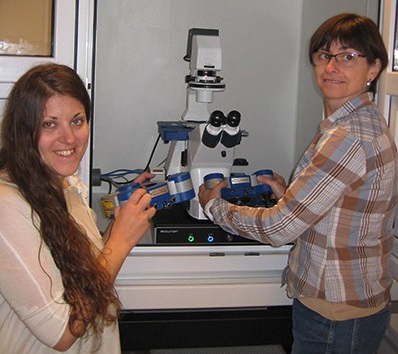Members Login

Channels
Special Offers & Promotions
JPK Reports the Exploration of Living Cells Using Nanoscale and Single Molecule Techniques Through the Application of Scanning Probe Microscopy in the Group of Yves Dufr
JPK Instruments, a world-leading manufacturer of nanoanalytic instrumentation for research in life sciences and soft matter, reports on the use of their NanoWizard® 3 AFM system at the Université catholique de Louvain where it is used by the nanobio team to look at the nanoscopy of living cells.
 Dr Yves Dufrêne is a senior research fellow who is leading the Nanobio Team at UCL, Université catholique de Louvain. His research is at the cross-roads of nanotechnology and microbiology where the goal is to gain insight into the nanometer-scale surface architecture and molecular interactions of microbes. Two main topics are: understanding the spatial organization of the cell wall and deciphering the molecular mechanisms of cell adhesion. The general strategy involves combining novel AFM modalities for probing bacterial cell surfaces (combined AFM-fluorescence imaging of live cells, high-speed imaging of cell surface structure, quantitative multiparametric imaging of cell surface properties, advanced single molecule and single-cell force spectroscopy measurements) with genetic and biophysical methods to characterize a range of organisms of biotechnological or biomedical importance. These nanoscale analyses will shed new light into the structure-function relationships of microbial cell surfaces.
Dr Yves Dufrêne is a senior research fellow who is leading the Nanobio Team at UCL, Université catholique de Louvain. His research is at the cross-roads of nanotechnology and microbiology where the goal is to gain insight into the nanometer-scale surface architecture and molecular interactions of microbes. Two main topics are: understanding the spatial organization of the cell wall and deciphering the molecular mechanisms of cell adhesion. The general strategy involves combining novel AFM modalities for probing bacterial cell surfaces (combined AFM-fluorescence imaging of live cells, high-speed imaging of cell surface structure, quantitative multiparametric imaging of cell surface properties, advanced single molecule and single-cell force spectroscopy measurements) with genetic and biophysical methods to characterize a range of organisms of biotechnological or biomedical importance. These nanoscale analyses will shed new light into the structure-function relationships of microbial cell surfaces.
Looking more deeply at his work, Dr Dufrêne says “the completion of our multidisciplinary research requires a novel, state-of-the-art AFM for the nanoscale analysis of live cells hence our choice of the NanoWizard® from JPK Instruments. This is equipped with a series of advanced capabilities that are essential for the project. First, the combination of AFM with a high-quality inverted optical microscope will allows us to optically guide AFM analyses (selection of a cell of interest, followed by targeted AFM measurements), therefore improving dramatically the throughput and quality of single-cell analyses. In addition, this AFM-optical microscopy platform will make it possible to directly correlate AFM topographic images with fluorescence images and to prepare living cell probes for single-cell force spectroscopy (SCFS) measurements. Secondly, the new high-speed module will complement traditional topographic imaging of bacterial cell surfaces by providing a more dynamic view of the cell surface (cell surface organization, relaxation and turnover; cell wall remodelling in response to drugs). We believe this project is a unique opportunity to push the limits of high-speed AFM in microbiology. Third, an advanced single-molecule force spectroscopy (SMFS) package will enable us to image and manipulate, at high resolution, single cell surface constituents. This package will include the force-clamp mode, which will provide novel insights into the adhesive and mechanical properties of the adhesins. Fourth, the newly developed multiparametric imaging mode (also named quantitative imaging, QI™) will allow us to dramatically increase the spatiotemporal resolution of SMFS-based imaging, and to correlate the localization of single cell surface constituents with local changes in adhesion and elasticity. Fifth, the unique cell adhesion force module (CellHesion™ module) will guarantee reliable, state-of-the art single-cell force spectroscopy (SCFS) measurements, and will permit, for the first time, long-range z-spectroscopy (up to 100 µm), thereby enabling to unravel molecular interactions that were not accessible before.”
more news from JPK instruments
Media Partners


